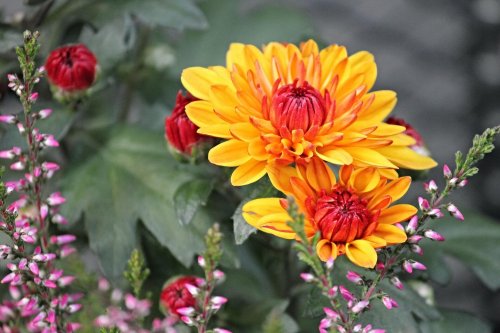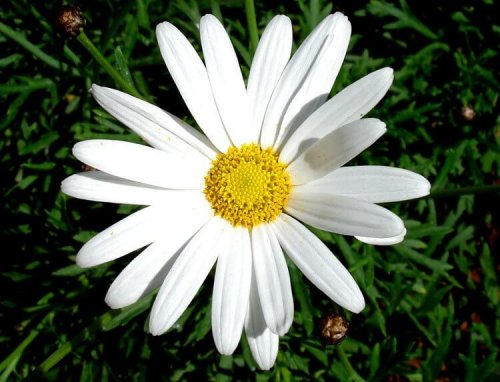Plants that You Can Use as Natural Flea and Tick Repellent

For some time now, many people have opted to use a natural repellent to combat fleas and ticks. While most of the options on the market are made of mild formulas approved by the U.S. Environmental Protection Agency (EPA), there are those who prefer to use natural ingredients as flea and tick repellent.
According to information published in Drugs, repellents are products that contain ingredients that make the person or pet unattractive to insects (in this case fleas and ticks). They act only on the area of the skin where they are applied and close to the treated surface.
The problem with fleas and ticks
Fleas are small insects that jump long distances and feed on blood after breaking the skin with their bites. According to a publication in the Caspian Journal of Internal Medicine, they can cause skin injuries that result in your pet scratching heavily, which can lead to them hurting themselves.
At the same time, these small bugs can also cause anemia and can transmit parasites to our pets. Therefore, once they are detected, measures must be taken to try to eliminate them.
There’s nothing more annoying for our pets than fleas and ticks.
Often, in our eagerness to remove them, we resort to chemicals that can damage their skin can cause allergies. Below, we’ll show you how you can use some plants as natural flea and tick repellent for you pet.
As for ticks, they are small mites that transmit parasites to warm-blooded animals like dogs, rabbits, sheep, and even people. They feed by sucking blood without causing burning or itching.
In children, they can harbor on the scalp. They’re quite dangerous because, as explained in a publication in the National Center for Biotechnology Information, they can cause Lyme disease and other chronic problems.
Plants as natural flea and tick repellent
It should be clear that plants aren’t as potent a repellent as commercial ones. However, they can be useful in many cases. Do you want know the options? In the following article, we’ll provide all the details.
Learn more: The Benefits of Mint Oil for Your Body
Mint

Mint is a plant with a refreshing aroma. In addition, according to information in Home Guides magazine,, it’s one of the most popular methods for eliminating fleas and ticks, as it’s safe for your pets.
You should be careful, however, because this is a plant that spreads easily and can take over your entire garden. To avoid this, put the plants in pots.
Garlic

Planting garlic in your garden is a great way to prevent ticks from bothering your pets. You can also crush some cloves up and spread them around the edges of your pet’s bed. It is a great natural repellent for other pests and, of course, for ticks. Be careful if you have cats, however, because it can be harmful to them.
Rosemary
This plant grows naturally throughout the Mediterranean region. If you care for it well, you can grow it perfectly fine in other climates as well. Besides it being a very effective repellent, it has two other properties: It has a light blue flower that makes for great decoration, it’s a good source of amino acids, and it’s great for seasoning meals.
Keep reading: Discover the Uses and Benefits of Rosemary
Chrysanthemums

This plant is great for decorating your garden because of its beautiful, colorful flowers. It also keeps ticks and fleas away from your home. This flower also fights off lice and cockroaches.
Put it at the edges of your garden or around other plants.
Lavender, the most popular plant to use as a natural flea and tick repellent

Lavender is part of the mint family. It is beautiful, has very colorful flowers, and an amazing smell. This plant is extremely safe for pets. And, in addition to keeping fleas and ticks away, it also repels moths and mosquitos, as reported in a study published in BioMed Research International.
Catnip
This herb is very similar to mint and cats love it. It secretes an intense menthol smell that entices cats while also protecting them from fleas. Its leaves are often used when making cat toys.
Lemongrass
Lemongrass has many properties, including it being an antiseptic, a digestive, and a natural flea repellent. It is often used in cooking because of its intense smell and flavor.
Daisies

Its full name is the Margarita Fleabane Daisy and it has beautiful, white flowers with white leaves and a yellow center. Its beauty makes it a very popular flower to have in the garden.
It’s also a very good flea, mosquito and fly repellent that is not dangerous for your pets. You can rub the leaves of this flower right onto your animal’s fur.
Purple salvia
This plant grows wild in many places, but it can also be planted in patios and gardens. Salvia is a natural flea repellent that smells good. It’s very safe for pets and its aroma triples after it rains. Plant it in your garden and enjoy its benefits.
The veterinarian’s help is important
We can use these natural plants as allies to keep fleas and ticks away. However, if we do not manage to eliminate them, we will have to seek professional help. Remember that these insects can harm our health and that of our pets, so it is essential to find effective methods to eliminate them.
All cited sources were thoroughly reviewed by our team to ensure their quality, reliability, currency, and validity. The bibliography of this article was considered reliable and of academic or scientific accuracy.
- LNI Carlos Adrián Pizarro Ríos. Ideas Para Una Casa Ambiental. Palibrio, 2013.
- Jorge de las Heras, Concepción Fabeiro, Ramón Meco. Fundamentos de agricultura ecológica: realidad actual y perspectivas. Universidad de Castilla La Mancha, 2003.
- James A. Duke. La Nueva Farmacia Natural: Alimentos curativos para prevenir y tratar más de 75 males comunes. Rodale, 2010.
- Youssefi MR, Ebrahimpour S, Rezaei M, Ahmadpour E, Rakhshanpour A, Rahimi MT. Dermatitis caused by Ctenocephalides felis (cat flea) in human. Caspian J Intern Med. 2014;5(4):248–250.
-
Institute of Medicine (US) Committee on Lyme Disease and Other Tick-Borne Diseases: The State of the Science. Critical Needs and Gaps in Understanding Prevention, Amelioration, and Resolution of Lyme and Other Tick-Borne Diseases: The Short-Term and Long-Term Outcomes: Workshop Report. Washington (DC): National Academies Press (US); 2011. 2, An Overview of Tick-Borne Diseases. Available from: https://www.ncbi.nlm.nih.gov/books/NBK57013/
This text is provided for informational purposes only and does not replace consultation with a professional. If in doubt, consult your specialist.








